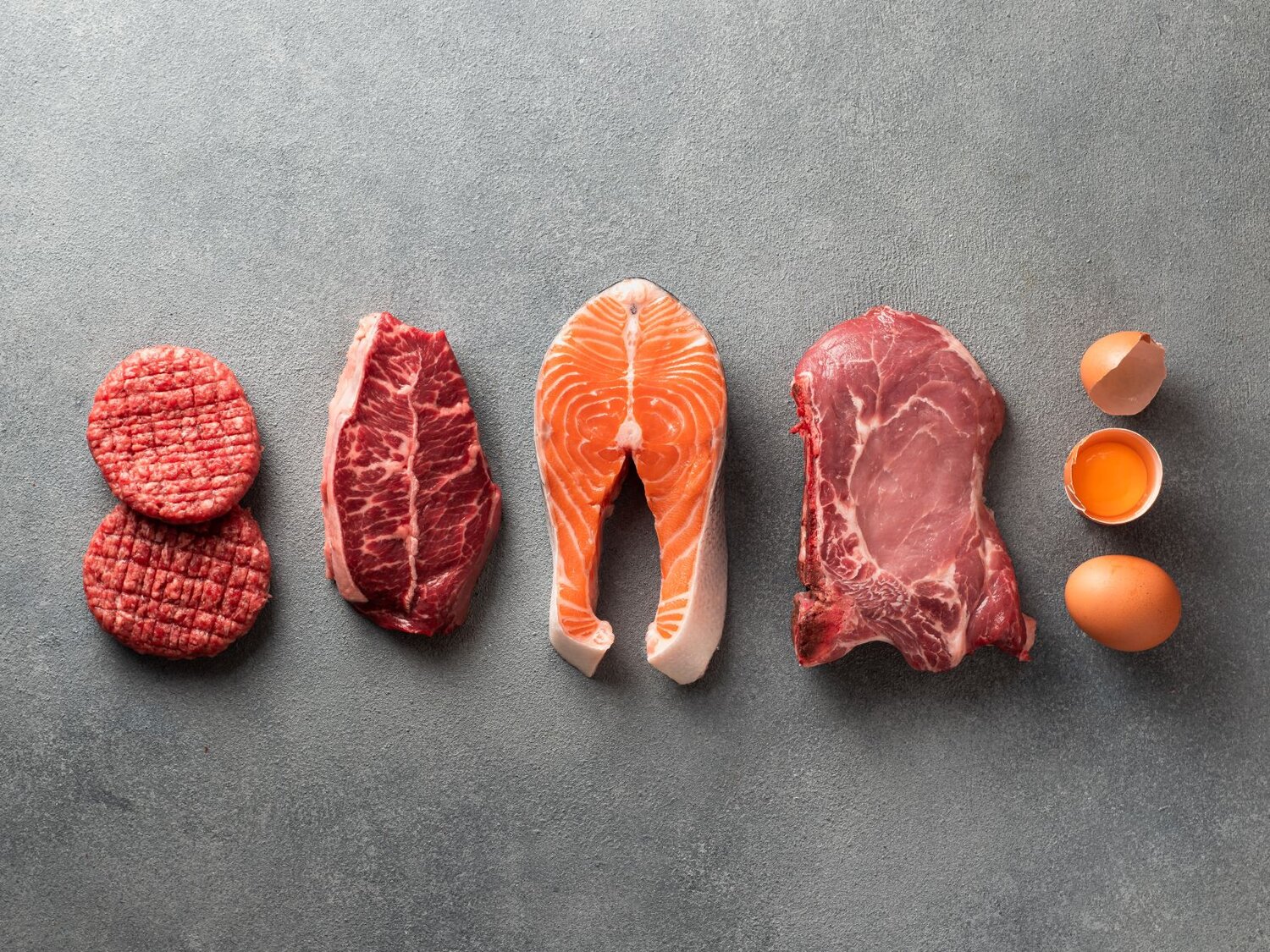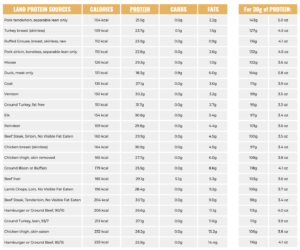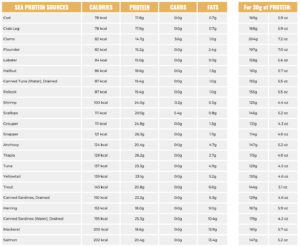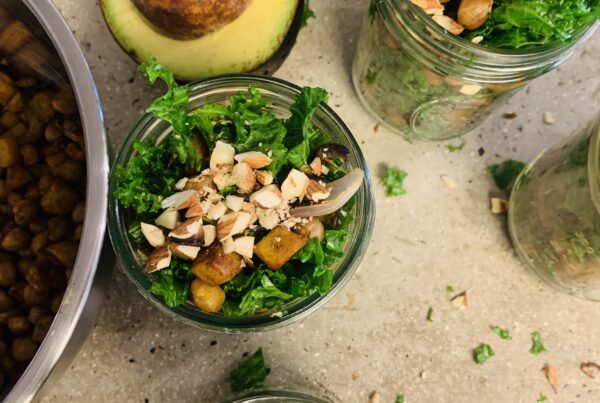In preparation for writing this article, I gathered a few papers and resources to explain the trends in protein consumption, particularly in America. It is hard to find clear and reliable data, without going through multiple publications. A lot of the studies are biased, outdated, complicated to understand, or don’t translate to certain groups of people, and textbooks are based on RDA (Recommended Dietary Allowance), which is usually on the low end and not optimal for everyone. Lots of information to sort through.
A Predominance of Animal Protein Over Plant-Based Options
To summarize some of the data published by USDA, HHS, and scientific journals, Americans tend to eat more protein than what is recommended and most are animal-sourced, which demonstrates that eating at least the minimum required amount of protein doesn’t seem to be a problem for the general population.
The ideal protein intake is related to one’s lean muscle mass (somewhere between 0.8 to 2.2g of protein per Kg of body weight) and level of activity, so it is difficult to calculate precisely and generally. When it comes to active women and men, there are more variables. The one and only Dr. Stacy Sims talks more about it in this article geared toward women.
To understand more about the American diet simply look at the menus in popular restaurants, which generally lack plant-based options likely due to unpopularity, people’s grocery carts and meat section at stores, and the marketing from the food industry, particularly fast foods. It’s not a surprise that animal protein has a very strong presence in the general public’s diet (except vegans and vegetarians).
Eating enough protein is crucial for performance and overall health. Getting it from animals isn’t necessarily a problem (if we don’t mention environmental issues) but from a nutritional perspective, the issue could be the lack of plants in one’s diet, which can also be a source of protein, such as legumes, grains, nuts, and seeds and provide significant nutrients necessary for body functions.
Grams of Protein
Learning how to get protein from a variety of sources is probably the best you can do if the goal is to consume the high end of the recommended protein daily.
Fruits, vegetables, and dark greens contain some protein as well, which adds up to the total at the end of the day, so it’s important to “eat the rainbow”. This is especially important for vegans, who might need to supplement their diet with protein powders and BCAAs.
Let’s take myself as an example: I’m an active woman, 119lb. 100g of protein is at the high end of my protein needs. A fair portion of animal protein still gives me a lot of room to eat plenty of other types of protein. It means that purposefully including plant protein in my diet will help me reach that high end and allow more diversity, fiber, phytonutrients, micronutrients, and volume in my diet. Relying only on animal-sourced proteins can result in the lack of nutrients found only in plants and whole foods.
Each one of the portions listed below contains 30g of protein (120g of chicken DOES NOT equal 120g of protein!). Take a look and explore how you can add more different types of protein to your diet.
Focus on variety and whole foods, rather than calories, and make sure to include protein in every single meal and snack. A piece of chicken can be eaten with rice and beans, fish will go well with nuts, and oats with protein powder make great overnight oats!
Animal-Based Protein Sources (each portion below contains approx 30g of protein)
- Chicken Breast: About 120 grams (4.2 ounces) of cooked chicken breast.
- Beef: Around 100 grams (3.5 ounces) of cooked lean beef.
- Salmon: Approximately 140 grams (5 ounces) of cooked salmon.
- Tuna: A can (about 150 grams or 5.3 ounces) of tuna in water.
- Eggs: 5 large eggs.
- Shrimp: About 150 grams (5.3 ounces) of cooked shrimp.
- Pork Chops: Around 120 grams (4.2 ounces) of cooked pork chops.
- Turkey: About 120 grams (4.2 ounces) of cooked turkey breast.
Plant-Based Protein Sources
- Lentils: Approximately 200 grams (7 ounces) of cooked lentils.
- Chickpeas: Around 240 grams (8.5 ounces) of cooked chickpeas.
- Black Beans: About 240 grams (8.5 ounces) of cooked black beans.
- Tofu: Approximately 300 grams (10.5 ounces) of firm tofu.
- Tempeh: Around 150 grams (5.3 ounces) of tempeh.
- Quinoa: About 350 grams (12.3 ounces) of cooked quinoa.
- Edamame: Around 150 grams (5.3 ounces) of cooked edamame.
- Seitan: Approximately 100 grams (3.5 ounces) of seitan.
- Peanut Butter: About 6 tablespoons of peanut butter.
Dairy and Dairy Alternatives
- Greek Yogurt: About 300 grams (10.5 ounces) of Greek yogurt.
- Cottage Cheese: Around 300 grams (10.5 ounces) of cottage cheese.
- Cheddar Cheese: Approximately 120 grams (4.2 ounces) of cheddar cheese.
- Protein Powder: Typically, 1-2 scoops of protein powder, depending on the brand.
- Soy Milk: About 1 liter (33.8 ounces) of soy milk.
Nuts and Seeds
- Hemp Seeds: Around 100 grams (3.5 ounces) of hemp seeds.
- Pumpkin Seeds: About 150 grams (5.3 ounces) of pumpkin seeds.
- Chia Seeds: Around 10 tablespoons of chia seeds.
- Nutritional Yeast: Approximately 12 tablespoons of nutritional yeast.
- Almonds: About 150 grams (5.3 ounces) or approximately 1 cup.
- Peanuts: Around 110 grams (3.9 ounces) or approximately 3/4 cup.
- Walnuts: About 200 grams (7 ounces) or approximately 2 cups.
- Pistachios: Around 150 grams (5.3 ounces) or approximately 1 cup.
- Cashews: About 165 grams (5.8 ounces) or approximately 1 cup.
- Hazelnuts: Around 175 grams (6.2 ounces) or approximately 1.5 cups.
- Brazil Nuts: About 160 grams (5.6 ounces) or approximately 1 cup.
- Pine Nuts: Around 200 grams (7 ounces) or approximately 1.5 cups.
These amounts are approximate and can vary based on the specific product or preparation method. Always check nutritional labels for the most accurate information.
When it comes to fueling your body to overcome health issues and optimizing performance, protein is crucial, along with other nutritional strategies that can support your goals. Speaking to a holistic doctor or a nutritionist can help you get informed and clarity on what serves your body. Everyone has a unique biology so experimenting and learning about your body will be part of the process.
Reach out if you want to learn more about how I can help you reach your goals.
I work on educating active adults about the foundations of nutrition, as well as providing personalized functional nutrition recommendations based on your health issues and goals.







